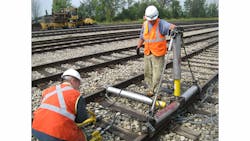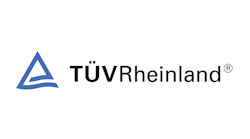Statistically, passenger train derailments contribute relatively little to the total count of derailments in the U.S. There were 12 passenger train accidents out of 1,277 overall reportable derailments in 2013. Even one rail accident is too many where human lives are concerned as the public is reminded when tragedies happen, such as last year’s accident on the outskirts of Santiago de Compostela in Spain.
This article intends to educate the reader about derailment causes and prevention methods for the passenger type of service; however, it does not intend the information to be all-inclusive or describe any specific accident.
From a railroad perspective, all derailments — passenger and freight — are caused approximately one-third by track, one-third by equipment and one-third by human factors. This article focuses on the track and human factor causes because they are almost solely responsible for the passenger derailments. Out of 12 above-mentioned accidents two-thirds were due to track and one-third due to human error causes.
A small number of accidents, such as weather-related accidents, fall outside these categories but the number is negligible. While a broken rail could be more prevalent in extremely cold weather, it remains a track failure from a railroad perspective.
The cause of derailments is most often a combination of factors, such as both a railcar and the track structure in poor condition. In such cases, attempts are made to determine the primary cause while identifying a contributing cause; sometimes, simulations are the only way to decide which is which.
Accidents Caused by Track Failures
Broken Rails
The most frequent cause of track-related accidents is broken rails. A preventative method commonly used is ultrasonic testing of the rail because it tests the interior of the rail where defects develop, especially on routes with frequent high tonnages. Most railroads test main tracks about every 90 days on high-tonnage routes and will replace defective rails as soon as they find them.
Track Geometry
Track geometry problems are also common. Wide gage is one type of a track geometry failure resulting in wheels falling in between the rails. This is often related to tie conditions, especially if wood ties are old, and often occurs in yards at slow speeds, but can also happen on the main track.
Another geometry problem is crosslevel, a relative elevation of one rail with respect to the other. Crosslevel failures are usually found on jointed rails, rails laid in lengths of around 66 feet and bolted to each other with joint bars, and can lead to "rock and roll," derailments at lower speeds at around 15 mph. Because most main tracks are now continuously welded rail, this failure is rare on main tracks. Most railroads operate track geometry cars over their main tracks on a regular basis, usually every three to six months, checking on track geometry and will correct any problems.
Additionally, M-Rail testing is used to evaluate track geometry. M-Rail employs an instrumented loaded freight car to evaluate the vertical stability of the track structure, including the subgrade, and can find locations with severe vertical deflections.
Track buckles
Track buckles happen when large sections of steel shrink as the temperature drops and expand as it increases. When stresses on the rail become too great, the tracks may buckle. Track buckles appear to have been increasing, likely due to hot summers, heavier trains applying higher forces to the track, and low rail neutral temperatures (RNT). RNT is an occurrence when the rails expand due to heat and kick out laterally. This usually occurs in welded rail that expands in the summer due to temperature increases. This can happen if the rail is not properly distressed and the track structure is weak, such as poor ties or poor ballast section. One method of preventing track buckles is the VERSE testing, with one of its main advantages being the ability to provide the rail neutral temperature without the need to cut the rail.
When Human Error Comes Into Play
Human errors that typically cause accidents include failure to comply with rules and improper train operations and train handling.
Failure to Comply With Rules
Human mistakes commonly happen when a person is operating a railroad switch, a mechanical installation enabling railway trains to be guided from one track to another. Think about a railway junction or where a spur or siding branches off. Some of the primary human factor failures causing derailments in switching are shoving movements without protection known as blind shoves, improper inspection and lining of switches, and passed coupler derailments, when cars do not couple correctly and crew personnel fails to notice that.
Improper Train Operations
Excessive speed often causes an accident in main track train operations when a train engineer either goes over the maximum speed or ignores a speed restriction such as a slow order or curve restriction, although these happen less frequently since the implementation of locomotive event recorders over the last 30 years. A train engineer may fail to comply with signal indications, fail to operate at a restricted speed and stop within one-half the range of vision not exceeding 20 mph, or exceed the limits of authority in a non-block territory where there are no signals.
Improper Train Handling
When an engineer makes an error while operating the train — classified as improper train handling — he creates excessive train forces, which, solely or in conjunction with other car or track conditions, may result in a derailment. An example of this is rapid or excessive throttle modulation or braking application by the engineer, resulting in slack run-in causing high forces throughout the train sufficient to cause wheel lift in coaches in curves or track switches. More common, but just as important, are passenger injuries from spilled beverages, falling baggage, and falls because of a slack action due to improper train handling. Fortunately, railroads train and monitor engineers routinely, as mandated by the Federal Railroad Administration, to prevent this from occurring.
Preventing Accidents
Comprehensive derailment prevention and investigation training is performed regularly to reduce railroad accidents. It includes proper cause finding in case of a derailment so that appropriate corrective actions can be implemented to avoid repeated accidents in the future.
Simulator training of new locomotive engineers and retraining of current engineers is being performed across the railroad industry allowing engineers to “view” the forces that can be generated in typical trains they handle. When positive train control (PTC) is implemented by railroads, it is likely to prevent many collisions and derailments associated with human failures.
Assuming Responsibility
From the railroad operations perspective, rule of thumb is that if a derailment occurs on a railroad company’s track and its crew has accepted the train or cars in interchange from another railroad, then the railroad assumes the derailment responsibility and cost. An exception to this would be some type of equipment latent defect or if the car is improperly loaded but these cases are rare.
Everyone in the railroad industry attempts to keep the operations as safe as possible by building good equipment, operating trains safely and properly testing and implementing new technologies, such as distributed power, remote control and various new car and track designs and components, performed jointly by railroads and testing operations.
Larry Guthrie is general director, Operations Analysis, with TÜV Rheinland Mobility Inc. and Sebastian Oertel is chief operating officer with TÜV Rheinland Mobility Inc.




